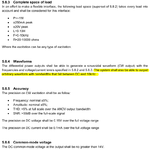Nurahmed
Junior Member level 1
- Joined
- May 27, 2019
- Messages
- 19
- Helped
- 1
- Reputation
- 2
- Reaction score
- 1
- Trophy points
- 3
- Location
- Montreal, Canada
- Activity points
- 172
Not lower than imposed by the Nyquist criterion. In practice at least 25 to 30 kHz, higher if you want to keep the filter effort low.
If I want a 10kHz sine wave, by Nyquist criteria, 25kHz to 30kHz should be my filter's cut-off frequency, right? It is not carrier frequency. I think Carrier frequency should be much higher, but I don't know how to choose the carrier frequency.
